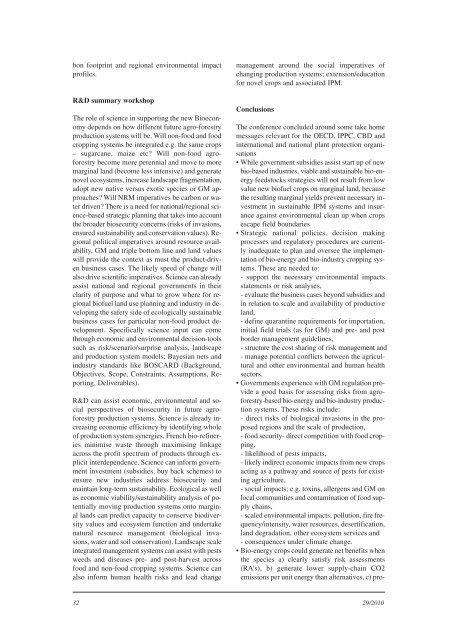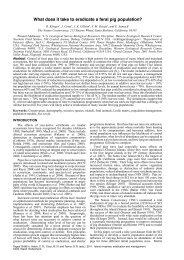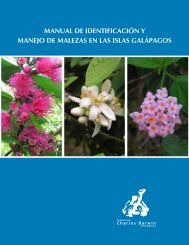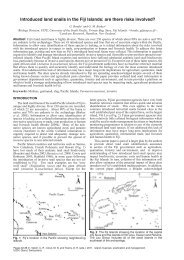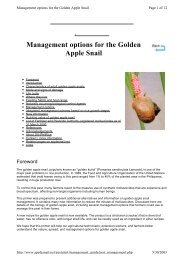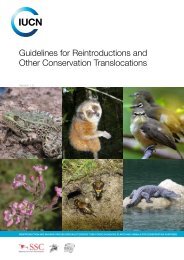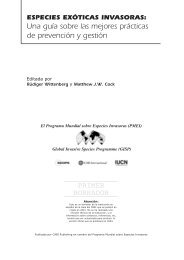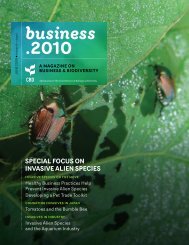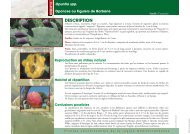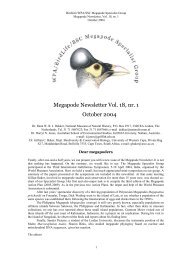Aliens Newsletter - ISSG
Aliens Newsletter - ISSG
Aliens Newsletter - ISSG
Create successful ePaper yourself
Turn your PDF publications into a flip-book with our unique Google optimized e-Paper software.
on footprint and regional environmental impact<br />
profiles.<br />
R&D summary workshop<br />
The role of science in supporting the new Bioeconomy<br />
depends on how different future agro-forestry<br />
production systems will be. Will non-food and food<br />
cropping systems be integrated e.g. the same crops<br />
– sugarcane, maize etc? Will non-food agroforestry<br />
become more perennial and move to more<br />
marginal land (become less intensive) and generate<br />
novel ecosystems, increase landscape fragmentation,<br />
adopt new native versus exotic species or GM approaches?<br />
Will NRM imperatives be carbon or water<br />
driven? There is a need for national/regional science-based<br />
strategic planning that takes into account<br />
the broader biosecurity concerns (risks of invasions,<br />
ensured sustainability and conservation values). Regional<br />
political imperatives around resource availability,<br />
GM and triple bottom line and land values<br />
will provide the context as must the product-driven<br />
business cases. The likely speed of change will<br />
also drive scientific imperatives. Science can already<br />
assist national and regional governments in their<br />
clarity of purpose and what to grow where for regional<br />
biofuel land use planning and industry in developing<br />
the safety side of ecologically sustainable<br />
business cases for particular non-food product development.<br />
Specifically science input can come<br />
through economic and environmental decision-tools<br />
such as risk/scenario/surprise analysis, landscape<br />
and production system models; Bayesian nets and<br />
industry standards like BOSCARD (Background,<br />
Objectives, Scope, Constraints, Assumptions, Reporting,<br />
Deliverables).<br />
R&D can assist economic, environmental and social<br />
perspectives of biosecurity in future agroforestry<br />
production systems. Science is already increasing<br />
economic efficiency by identifying whole<br />
of production system synergies. French bio-refineries<br />
minimise waste through maximising linkage<br />
across the profit spectrum of products through explicit<br />
interdependence. Science can inform government<br />
investment (subsidies, buy back schemes) to<br />
ensure new industries address biosecurity and<br />
maintain long-term sustainability. Ecological as well<br />
as economic viability/sustainability analysis of potentially<br />
moving production systems onto marginal<br />
lands can predict capacity to conserve biodiversity<br />
values and ecosystem function and undertake<br />
natural resource management (biological invasions,<br />
water and soil conservation). Landscape scale<br />
integrated management systems can assist with pests<br />
weeds and diseases pre- and post-harvest across<br />
food and non-food cropping systems. Science can<br />
also inform human health risks and lead change<br />
management around the social imperatives of<br />
changing production systems; extension/education<br />
for novel crops and associated IPM.<br />
Conclusions<br />
The conference concluded around some take home<br />
messages relevant for the OECD, IPPC, CBD and<br />
international and national plant protection organisations<br />
• While government subsidies assist start up of new<br />
bio-based industries, viable and sustainable bio-energy<br />
feedstocks strategies will not result from low<br />
value new biofuel crops on marginal land, because<br />
the resulting marginal yields prevent necessary investment<br />
in sustainable IPM systems and insurance<br />
against environmental clean up when crops<br />
escape field boundaries<br />
• Strategic national policies, decision making<br />
processes and regulatory procedures are currently<br />
inadequate to plan and oversee the implementation<br />
of bio-energy and bio-industry cropping systems.<br />
These are needed to:<br />
- support the necessary environmental impacts<br />
statements or risk analyses,<br />
- evaluate the business cases beyond subsidies and<br />
in relation to scale and availability of productive<br />
land,<br />
- define quarantine requirements for importation,<br />
initial field trials (as for GM) and pre- and post<br />
border management guidelines,<br />
- structure the cost sharing of risk management and<br />
- manage potential conflicts between the agricultural<br />
and other environmental and human health<br />
sectors.<br />
• Governments experience with GM regulation provide<br />
a good basis for assessing risks from agroforestry-based<br />
bio-energy and bio-industry production<br />
systems. These risks include:<br />
- direct risks of biological invasions in the proposed<br />
regions and the scale of production,<br />
- food security- direct competition with food cropping,<br />
- likelihood of pests impacts,<br />
- likely indirect economic impacts from new crops<br />
acting as a pathway and source of pests for existing<br />
agriculture,<br />
- social impacts; e.g. toxins, allergens and GM on<br />
local communities and contamination of food supply<br />
chains,<br />
- scaled environmental impacts, pollution, fire frequency/intensity,<br />
water resources, desertification,<br />
land degradation, other ecosystem services and<br />
- consequences under climate change.<br />
• Bio-energy crops could generate net benefits when<br />
the species a) clearly satisfy risk assessments<br />
(RA’s), b) generate lower supply-chain CO2<br />
emissions per unit energy than alternatives, c) pro-<br />
32 29/2010


